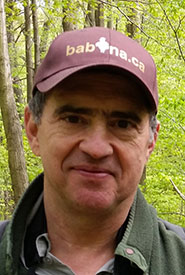Cruising for birds
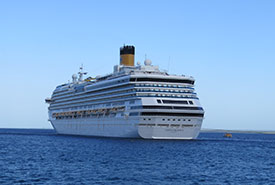
Our 14-deck mammoth cruise ship ― Costa Pacifica (Photo by Rob Alvo)
If you want to see many species of birds, you will undoubtedly be faced with a choice: visit only one or two sites to maximize the chances of seeing what is present, or visiting many sites to maximize the number of species that don’t require too much searching. Birders, when pressed, and we always are, can cover considerable ground. This can be done by car, bike, foot or boat, or even by airplane or helicopter.
For so long now, I’ve been hearing about cruise ships taking tourists across the oceans to all corners of the Earth, but I never thought that I’d do a cruise myself. However, in chatting with a travel agent about the possibilities of taking a week down south for a relaxing vacation and only a little bit of local birding, we ended up organizing a one-week cruise that featured outstanding birding, great meals and excellent accommodations, albeit little relaxation. Each of the islands we were to visit had some bird species that occur nowhere else in the world or that occur on only a few Caribbean Islands. The question was whether it made sense to try packing in a few islands in only a few days.
We flew from Toronto to Punta Cana, located in the southeastern corner of the Dominican Republic. We then transferred by dedicated bus to the port of La Romana. Upon arrival, we couldn’t believe our eyes at the sight of the 14-deck mammoth docked before us!
The cruise consisted of visiting five widely separated Caribbean islands (representing four countries) over six days, with the seventh day taking us back to La Romana. The idea was to allow people to visit an island during the day, with the ship travelling at night to the next island.
Birding five ways
We decided to test five modes of birding: heading off by foot from the cruise’s landing, going with a birding pal, paying for an organized excursion, taking cabs and renting a car.
Catalina Island
Coral stone Catalina Island, two and a half kilometres from mainland Dominican Republic, was the ship’s first stop. Smaller tender boats ferried tourists from the ship to the beach. We did a quick exploration and found that most of the beach itself was surrounded by a wall outside of which we were not allowed — too bad because the rest of the island looked green and potentially birdy on maps. But the unwalled portion featured a 450-metre-long nature trail through forest and shrublands. Feeling a little stuck, we birded the short nature trail several times, which got us some new birds.
St. Kitts
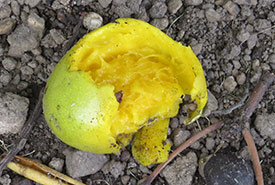
Half eaten mango by one of many wasteful green varvet monkeys introduced to St. Kitts that damage agricultural produce. (Photo by Rob Alvo)
St. Kitts is a former British colony where we had arranged for a local birding pal to take us around. We birded the Romney Gardens and nearby tropical forest, then some brackish ponds at the other end of the island until dark. Having a birding pal take us around St. Kitts in his own car provided excellent birding, including seeing some birds that we likely would not have found on our own given that he knew where to find them and recognized their vocalizations. He turned out to be a very good contact regarding a possible conservation project on the island, perhaps in conjunction with a Canadian university.
Antigua
On Antigua, another former British colony, we took an organized excursion to a beach that we knew was close to McKinnon’s Pond, a known birding spot. But after an hour and a half of birding, there was nothing else to see. Then we took a cab to take us to the Christian Valley Bird Trail. Surprisingly, our driver knew his birds, and I may have convinced him to become a birding pal.
Martinique and Guadeloupe
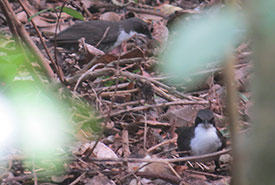
White-breasted thrasher, bird endemic to Martinique and St. Lucia. Listed as endangered by the IUCN. (Photo by Rob Alvo)
Martinique and Guadeloupe are both overseas regions of France, with Euros and a genuine feeling of being near Marseille. On Martinique, we took a cab to Presqu’ile de la Caravelle, a nature reserve an hour’s drive across the island. There, we spotted white-breasted thrasher, which occurs only on Martinique and St. Lucia, and numbers only about 1,900 individuals.
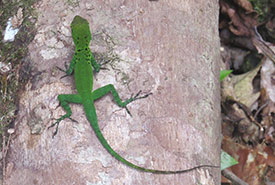
Other non-bird species we spotted during our trip ― Mountain Guadeloupe anole (Photo by Rob Alvo)
On Guadeloupe, we rented a car for the day and visited Cascades aux Écrivisses, then some lowland green areas. Our two best birds were the Guadeloupe woodpecker, which occurs only on Guadeloupe, and the brown trembler, which indeed trembles.
We even saw a pelagic bird from our balcony on the ship. It was impossible to miss catching our ship’s departure while using this birding mode! Pelagic birds are species that live far out at sea, except for during the short period when they are nesting on land. It was a sooty shearwater, a bird that I’d seen only twice before, on special pelagic birding trips.
I ended up seeing 12 lifers — birds that I saw for the first time in my life — and concluded that each birding method has its advantages and disadvantages, but in the end they can all work. The fact that we did considerable map work and other research to figure out a plan for each island helped us greatly. None of the birding methods, however, could eliminate the ever-present possibility that we would miss our cruise ship’s departure!
Conservation abroad and back home
As a conservation biologist, whenever I have the opportunity to bird in a different country, I’m always interested in learning about the country's conservation issues, which are often different manifestations of the same issues we face in Canada. For example, habitat loss is the number one threat to biodiversity worldwide, but habitat loss from hurricanes and tree-cutting for charcoal are Caribbean problems, not Canadian problems.
Invasive species are likely the number two threat to biodiversity worldwide, but the mongoose is a Caribbean problem, not a Canadian one (we have cats and rats). Canadians wondering to what degree we should care about Carribbean birds should consider that many of our migratory birds migrate through or overwinter there and that we have non-migratory species in common.
And I want to know things like whether folks in Antigua talk about climate change too, just like us. They do.
Final thoughts on cruising for birds
Even though my binoculars usually hung around my neck while on the ship, I didn’t see any of the 3,600 other travellers or 1,000 crew members with a pair. No one ever asked me if I was a birder, so I had to conclude that there were few if any other birders on board. An opportunity missed!
Yes, the food on the ship was excellent. And there was certainly lots to do, including shopping, swimming, relaxing, gambling, partying, attending classes, presentations and shows, and anything else one can do on a non-floating city. Another pleasure was meeting interesting folks from different countries.
Culturally? Well, with our rushing around while on island forays to bird, we didn’t concentrate on cultural exchanges. Nevertheless, it was only by speaking with locals that we learned that broad-winged hawks are called "owls" in Antigua, where there are actually no owls (the island lost its burrowing owls). In Martinique, however, the same species is known in French as a “malfini,” meaning unfinished. This refers to a belief that the hawks kill their mammalian prey but don’t finish eating it. This was a pleasant reminder of the importance of standardized bird names, but also the pleasure of local names.
Would I go on another cruise to bird, eat well and not relax? Absolutely.

